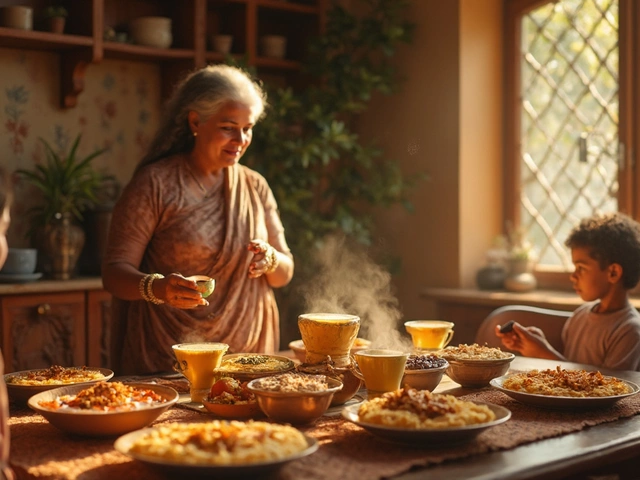
If you look at modern diet trends, there’s always a new rule about when to eat—intermittent fasting, snacking often, skipping breakfast. Ayurveda shrugs at the fads and keeps it super clear: eat two or three solid meals a day, and make sure you’re actually hungry.
That’s right, no constant grazing or late-night snacking if you’re following the old-school wisdom. Why? According to Ayurveda, your digestive fire—or “Agni”—needs time to power up, handle what you eat, and reset. When you keep throwing in snacks, your system never gets a break, and that can mess up everything from your energy to your mood.
In Ayurvedic thinking, meal frequency isn’t just about portions. It’s about giving your gut enough space to work its magic so you get real nourishment, not just calories. The idea is simple: finish one meal, digest it, then have the next. Your stomach shouldn’t feel crammed, but you shouldn’t go hungry either.
- Ayurveda's Core Meal Frequency Principle
- Why Meal Timing Matters for Digestion
- Personalizing Eating Habits: Dosha Differences
- Practical Tips for Following Ayurveda’s Meal Schedule
Ayurveda's Core Meal Frequency Principle
Ayurveda says there’s no need to eat all day long. Instead, you should have two or three real meals, spaced out so your body can properly digest each one. This old-school advice is built on how our digestion actually works, not on modern snacks or packaged foods. The thinking is simple: don’t ask your stomach to multitask.
Instead of just “eating when you’re bored,” Ayurveda suggests eating only when you truly feel hungry. Hunger is a sign your last meal’s been digested and your digestive fire—what’s called “Agni”—is ready for the next round. When people ignore hunger cues and just snack from habit, digestion gets weaker.
Here’s the Ayurvedic meal breakdown most experts follow:
- Breakfast: Only if you’re actually hungry in the morning, keep it nourishing but not too heavy.
- Lunch: This should be your biggest meal, taken when the sun is highest—usually around noon. That’s when Ayurveda says digestive fire is at its peak. Go for something filling but not greasy.
- Dinner: Make this your lightest meal, taken before it gets dark. Give your stomach a few hours to finish up before you head to bed.
Ayurveda claims that eating like this helps balance your energy, moods, and even your immune system. A survey of Indian adults published in 2022 showed that people who stuck to a two-to-three meal routine felt less bloated and had better sleep quality than those with random eating patterns.
| Meal | Ideal Time | Ayurvedic Reasoning |
|---|---|---|
| Breakfast | 7–9 a.m. | Only if hungry; lighter to start the day |
| Lunch | 12–2 p.m. | Biggest meal; strongest digestion |
| Dinner | 6–8 p.m. | Light; allows body to rest overnight |
So, the next time you’re tempted to reach for a snack, ask yourself if you’re really hungry or just keeping your digestive system busy for no reason. Less is more—at least if you’re taking tips from Ayurveda.
Why Meal Timing Matters for Digestion
Ayurveda is laser-focused on digestion. According to this system, when you eat is just as crucial as what you eat. Your body’s digestive strength, called Agni, isn’t on full blast all day—think of it like a real fire that gets stronger and weaker based on your daily rhythm.
Here’s a surprising fact: your Agni is at its peak between 10 a.m. and 2 p.m. This lines up with what many doctors say about lunch being the most important meal. Ayurveda says you should plan your biggest meal during this time, so your body can fully break down and use whatever you eat.
Eating randomly or late at night? That’s when Agni is low, and you’re more likely to get bloated, sluggish, or have random cravings. Imagine your stomach as a kitchen—if you throw in food when the stove’s barely warm, nothing cooks right. It’s the same with digestion. If you push your main meal to the evening, you’re not taking advantage of your natural digestive power.
If you want data to back this up, here’s a quick table showing how digestive strength works during your day:
| Time of Day | Digestive Strength (Agni) | Best Meal Choice |
|---|---|---|
| 6-10 a.m. | Weak | Light breakfast or just warm water |
| 10 a.m. - 2 p.m. | Strong | Main meal/lunch |
| 2-6 p.m. | Fading | Small snack if truly hungry |
| 6-10 p.m. | Weak | Light, early dinner |
Consistency also helps—eating at different times every day confuses your body and can make digestion less efficient. Ayurveda recommends sticking to roughly the same schedule so your body knows when to expect food and can get ready to digest it properly.
Bottom line: meal timing isn’t just an old tradition; it’s a hack for better energy, less bloating, and steady mood—basically, it keeps your system running like a well-oiled machine.

Personalizing Eating Habits: Dosha Differences
Ayurveda isn’t a one-size-fits-all approach, especially when it comes to how many times you should eat every day. It all comes down to your dosha—basically, your body’s main personality, whether that’s Vata, Pitta, or Kapha. Each dosha has its quirks, so the best eating routine isn’t the same for everyone.
Here’s a quick breakdown of what each dosha needs when it comes to meal frequency:
- Pitta people have the strongest digestive systems. They need regular meals because they burn energy fast. For most Pittas, three meals a day works best—breakfast, lunch (the biggest meal), and dinner. Skipping meals can make them irritable or even give them heartburn.
- Vata types run light and quick. They tend to get hungry often, but their digestion isn’t always steady. They do best with three smaller meals plus possibly a healthy snack if they feel their energy dropping. Long gaps between meals can leave them frazzled or spaced-out.
- Kapha folks are slow and steady. Their digestion is gentle and sometimes sluggish. Two main meals a day are usually enough. More than that can leave them feeling heavy or tired. Late dinners are especially tough for them, so keeping evening meals light or skipping them works well.
Here’s what the typical eating timetable looks like for each dosha:
| Dosha | Meals Per Day | Best Meal Times | Special Tips |
|---|---|---|---|
| Pitta | 3 | 7-8am (breakfast), 12-1pm (lunch), 6-7pm (dinner) | Don’t skip meals. Lunch should be biggest. |
| Vata | 3 + snack | 8am (breakfast), 12pm (lunch), 6pm (dinner), 4pm (snack if needed) | Keep meals warm, easy to digest; avoid raw and cold foods. |
| Kapha | 2 | 9am (breakfast), 2pm (lunch) | Skip or go light on dinner. Focus on veggie-heavy meals. |
The main thing to remember is that listening to your body is key. Your meal plan should support your energy—not just follow a rule from a book. And if you’re not sure about your own dosha, there are loads of easy quizzes online. Keep in mind, respecting your dosha's needs can make a huge difference in how you feel and how well you digest—core ideas in Ayurveda.
Practical Tips for Following Ayurveda’s Meal Schedule
Trying to fit an ayurvedic diet into a modern routine can sound tricky, but it’s actually pretty practical once you see how it works. You don’t have to turn your life upside down or give up your favorite foods to follow Ayurveda’s meal schedule—just a few adjustments here and there.
Here’s what helps most folks stick with it:
- Eat your biggest meal at lunch. Ayurveda says your digestion is strongest at midday. This is when your “Agni” or digestive fire is at its peak, so that’s the best time for heavier foods.
- Breakfast should be light and easy to digest. If you’re not hungry right when you wake up, it’s fine to wait a bit before eating. Go for something warm like porridge or a simple fruit bowl.
- Keep dinner simple and early. Try to eat at least two or three hours before bed, giving your stomach a break before sleep. A light soup, stew, or khichdi (a rice and lentil dish) is perfect.
- Avoid constant snacking. Give your belly time to finish one job before giving it another. If you feel hungry between meals, sip warm water or herbal tea to check if it’s true hunger or just boredom.
If you’re traveling, have crazy work shifts, or just have days when things go sideways, it’s okay to adapt. The main trick is to pay attention to your real hunger, not just your clock or cravings. And if you’re sick or doing heavy exercise, listen to your body—don’t force a strict routine if you’re genuinely hungry.
Pro tip: For anyone with kids, try to sync mealtimes as much as you can. Even Shadow, my easily excitable dog, thrives on a regular meal schedule. Consistency makes digestion smoother for everybody in the house—even the furry ones.





Rohan Talvani
I am a manufacturing expert with over 15 years of experience in streamlining production processes and enhancing operational efficiency. My work often takes me into the technical nitty-gritty of production, but I have a keen interest in writing about medicine in India—an intersection of tradition and modern practices that captivates me. I strive to incorporate innovative approaches in everything I do, whether in my professional role or as an author. My passion for writing about health topics stems from a strong belief in knowledge sharing and its potential to bring about positive changes.
view all postsWrite a comment